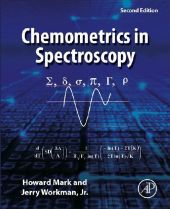 Neuerscheinungen 2018Stand: 2020-02-01 |
Schnellsuche
ISBN/Stichwort/Autor
|
Herderstraße 10
10625 Berlin
Tel.: 030 315 714 16
Fax 030 315 714 14
info@buchspektrum.de |

Howard Mark, Jerome Workman
(Beteiligte)
Chemometrics in Spectroscopy
2. Aufl. 2018. 1090 S. 229 mm
Verlag/Jahr: ACADEMIC PRESS 2018
ISBN: 0-12-405502-8 (0124055028) / 0-12-805309-7 (0128053097)
Neue ISBN: 978-0-12-405502-5 (9780124055025) / 978-0-12-805309-6 (9780128053096)
Preis und Lieferzeit: Bitte klicken
Chemometrics in Spectroscopy, Second Edition, provides the reader with the methodology crucial to apply chemometrics to real world data. It allows scientists using spectroscopic instruments to find explanations and solutions to their problems when they are confronted with unexpected and unexplained results. Unlike other books on these topics, it explains the root causes of the phenomena that lead to these results. While books on NIR spectroscopy sometimes cover basic chemometrics, they do not mention many of the advanced topics this book discusses. In addition, traditional chemometrics books do not cover spectroscopy to the point of understanding the basis for the underlying phenomena.
The second edition has been expanded with 50% more content covering advances in the field that have occurred in the last 10 years, including calibration transfer, units of measure in spectroscopy, principal components, clinical data reporting, classical least squares, regression models, spectral transfer, and more.
Written in the column format of the authors´ online magazine
Presents topical and important chapters for those involved in analysis work, both research and routine
Focuses on practical issues in the implementation of chemometrics for NIR Spectroscopy
Includes a companion website with 350 additional color figures that illustrate CLS concepts
Section 1. Elementary Matrix Algebra Section 2. Matrix Algebra and Multiple Linear Regression Section 3. Experimental Designs Section 4. Analytic Geometry Section 5. Regression Techniques Section 6. Linearity in Calibration Section 7. Collaborative Laboratory Studies Section 8. Analysis of Noise Section 9. Derivatives Section 10. Goodness of Fit Statistics Section 11. More About Linearity in Calibration Section 12. Connecting Chemometrics to Statistics Section 13. Limitations in Analytical Accuracy Section 14. Derivations of Principal Components Section 15. Clinical Data Reporting Section 16. Classical Least Squares (CLS) Section 17. Transfer of Calibrations Section 18. The Importance of Units of Measure Section 19. The Best Calibration Model Section 20. Statistics Section 21. Outliers Section 22. Spectral Transfer: Making Instruments Agree Section 23. Applying Standard Reference Materials Section 24. More About CLS


